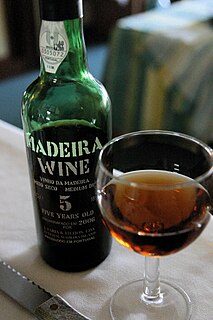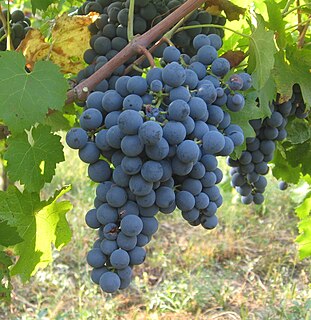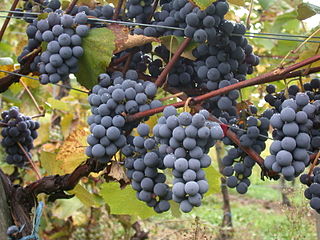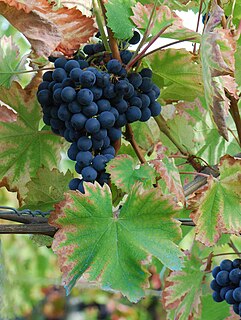Related Research Articles

Chardonnay is a green-skinned grape variety used in the production of white wine. The variety originated in the Burgundy wine region of eastern France, but is now grown wherever wine is produced, from England to New Zealand. For new and developing wine regions, growing Chardonnay is seen as a 'rite of passage' and an easy entry into the international wine market.

Cabernet Sauvignon is one of the world's most widely recognized red wine grape varieties. It is grown in nearly every major wine producing country among a diverse spectrum of climates from Australia and British Columbia, Canada to Lebanon's Beqaa Valley. Cabernet Sauvignon became internationally recognized through its prominence in Bordeaux wines where it is often blended with Merlot and Cabernet Franc. From France and Spain, the grape spread across Europe and to the New World where it found new homes in places like California's Santa Cruz Mountains, Paso Robles, Napa Valley, New Zealand's Hawke's Bay, South Africa's Stellenbosch region, Australia's Margaret River, McLaren Vale and Coonawarra regions, and Chile's Maipo Valley and Colchagua. For most of the 20th century, it was the world's most widely planted premium red wine grape until it was surpassed by Merlot in the 1990s. However, by 2015, Cabernet Sauvignon had once again become the most widely planted wine grape, with a total of 341,000 hectares (3,410 km2) under vine worldwide.

Madeira is a fortified wine made on the Portuguese Madeira Islands, off the coast of Africa. Madeira is produced in a variety of styles ranging from dry wines which can be consumed on their own, as an apéritif, to sweet wines usually consumed with dessert. Cheaper cooking versions are often flavoured with salt and pepper for use in cooking, but these are not fit for consumption as a beverage.

Sauvignon blanc is a green-skinned grape variety that originates from the Bordeaux region of France. The grape most likely gets its name from the French words sauvage ("wild") and blanc ("white") due to its early origins as an indigenous grape in South West France. It is possibly a descendant of Savagnin. Sauvignon blanc is planted in many of the world's wine regions, producing a crisp, dry, and refreshing white varietal wine. The grape is also a component of the famous dessert wines from Sauternes and Barsac. Sauvignon blanc is widely cultivated in France, Chile, Romania, Canada, Australia, New Zealand, South Africa, Bulgaria, the states of Oregon, Washington, and California in the US. Some New World Sauvignon blancs, particularly from California, may also be called "Fumé Blanc", a marketing term coined by Robert Mondavi in reference to Pouilly-Fumé.

Riesling is a white grape variety that originated in the Rhine region. Riesling is an aromatic grape variety displaying flowery, almost perfumed, aromas as well as high acidity. It is used to make dry, semi-sweet, sweet, and sparkling white wines. Riesling wines are usually varietally pure and are seldom oaked. As of 2004, Riesling was estimated to be the world's 20th most grown variety at 48,700 hectares, but in terms of importance for quality wines, it is usually included in the "top three" white wine varieties together with Chardonnay and Sauvignon blanc. Riesling is a variety that is highly "terroir-expressive", meaning that the character of Riesling wines is greatly influenced by the wine's place of origin.

Malbec is a purple grape variety used in making red wine. The grapes tend to have an inky dark color and robust tannins, and are known as one of the six grapes allowed in the blend of red Bordeaux wine. In France, plantations of Malbec are now found primarily in Cahors in South West France, though the grape is grown worldwide. It is increasingly celebrated as an Argentine varietal.

Pinot Gris, Pinot Grigio or Grauburgunder is a white wine grape variety of the species Vitis vinifera. Thought to be a mutant clone of the Pinot Noir variety, it normally has a grayish-blue fruit, accounting for its name, but the grapes can have a brownish pink to black and even white appearance. The word pinot could have been given to it because the grapes grow in small pinecone-shaped clusters. The wines produced from this grape also vary in color from a deep golden yellow to copper and even a light shade of pink, and it is one of the more popular grapes for skin-contact wine.

Cinsaut or Cinsault is a red wine grape whose heat tolerance and productivity make it important in Languedoc-Roussillon and the former French colonies of Algeria, Lebanon, and Morocco. It is often blended with grapes such as Grenache and Carignan to add softness and bouquet.

The Carménère grape is a wine grape variety originally planted in the Médoc region of Bordeaux, France, where it was used to produce deep red wines and occasionally used for blending purposes in the same manner as Petit Verdot.

Gamay is a purple-colored grape variety used to make red wines, most notably grown in Beaujolais and in the Loire Valley around Tours. Its full name is Gamay Noir à Jus Blanc. It is a very old cultivar, mentioned as long ago as the 15th century. It has been often cultivated because it makes for abundant production; however, it can produce wines of distinction when planted on acidic soils, which help to soften the grape's naturally high acidity.

Grüner VeltlinerGerman: [ˈgʁyːnɐ ˈfɛltˌliːnɐ](listen)) is a white wine grape variety grown primarily in Austria, Hungary, Slovakia, and the Czech Republic. The leaves of the grape vine are five-lobed with bunches that are long but compact, and deep green grapes that ripen in mid-late October in the Northern Hemisphere.

Grenache or Garnacha is one of the most widely planted red wine grape varieties in the world. It ripens late, so it needs hot, dry conditions such as those found in Spain, where the grape most likely originated. It is also grown in the Italian island of Sardinia, the south of France, Australia, and California's Monterey AVA and San Joaquin Valley.

Mourvèdre is a red wine grape variety grown in many regions around the world including the Rhône and Provence regions of France, the Valencia and Jumilla and Yecla denominaciones de origen (DOs) of Spain, as well as the Balearic Islands, California and Washington and the Australian regions of South Australia and New South Wales, as well as South Africa. In addition to making red varietal wines, Mourvèdre is a prominent component in "GSM" blends. The variety is also used to make rosé and port-style fortified wines.

Vidal blanc is a white hybrid grape variety produced from the Vitis vinifera variety Ugni blanc and another hybrid variety, Rayon d'Or. It is a very winter-hardy variety that manages to produce high sugar levels in cold climates with moderate to high acidity.

Greece is one of the oldest wine-producing regions in the world and among the first wine-producing territories in Europe. The earliest evidence of Greek wine has been dated to 6,500 years ago where wine was produced on a household or communal basis. In ancient times, as trade in wine became extensive, it was transported from end to end of the Mediterranean; Greek wine had especially high prestige in Italy under the Roman Empire. In the medieval period, wines exported from Crete, Monemvasia and other Greek ports fetched high prices in northern Europe.

Georgia is one of the oldest wine regions in the world. The fertile valleys and protective slopes of the Transcaucasia were home to grapevine cultivation and neolithic wine production for at least 8000 years. Due to the many millennia of wine in Georgian history and its prominent economic role, the traditions of wine are considered entwined with and inseparable from the national identity.

Fiano is a white Italian wine grape variety that is grown primarily in the Campania region of southern Italy and on the island of Sicily. In Campania, this fairly strong flavored white wine grape is particularly noted around Avellino where the Denominazione di origine controllata e Garantita (DOCG) wine of Fiano di Avellino is produced. The grape has a long history in the Campanian region and is believed to have been the grape behind the ancient Roman wine Apianum. Even today, the name Apianum is permitted to appear on wine labels of the DOCG wine Fiano di Avellino.

Santorini is a Greek wine region located on the archipelago of Santorini in the southern Cyclades islands of Greece. Wine has been produced there since ancient times, but it was during the Middle Ages that the wine of Santorini became famous worldwide under the influence of the Republic of Venice. The Italian influence is still present in modern Santorini winemaking: the most famous Tuscan sweet wine is called Vin Santo just like Santorini's Vinsanto/Visanto. It is made in a passito style from grapes dried in the sun after harvest.

Douce noir is a red Savoyard wine grape variety that has historically been grown in the Savoy region, but today is more widely planted in Argentina. The earliest mention of the grape dates from when Etruscans first planted Bonarda some 3.000 years ago in the Padana Region. It arrived in Savoie in the early 19th century, and by the end of the century it was the most widely grown red wine grape in the region. In the early 21st century it was discovered that the Bonarda grape, which is the 2nd most widely planted red grape, after Malbec, in Argentina was the Italian wine grape Bonarda Piemontese imported by Italian immigrants. The grape is also grown in California where it is known as Charbono.
Manto negro is a red Spanish wine grape variety grown on the Balearic islands. It is used in wines produced under the Binissalem-Mallorca and Plà i Llevant (DO) Denominación de Origen (DO)s, as well as the Illes Balears appellations. Today, Manto negro is almost exclusively found on the island of Majorca with 320 hectares, making it the most widely planted grape variety on the island. It represents over 20% of the total vineyard land in production. Although planted throughout the island, the vine seems to be more successful in the rocky soils of the western Binissalem region.
References
- 1 2 "Vugava Reviews". winemakingtalk.com. Archived from the original on 2013-05-04.
- ↑ "Vugava". croatianwines.wordpress.com.